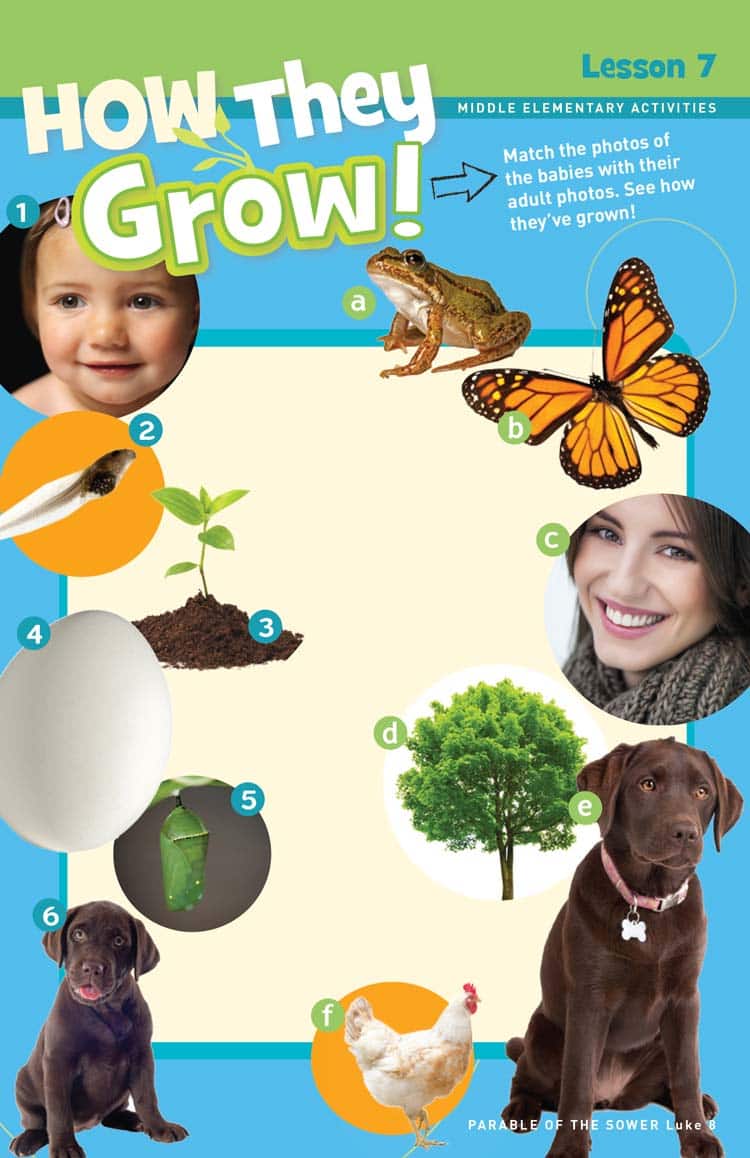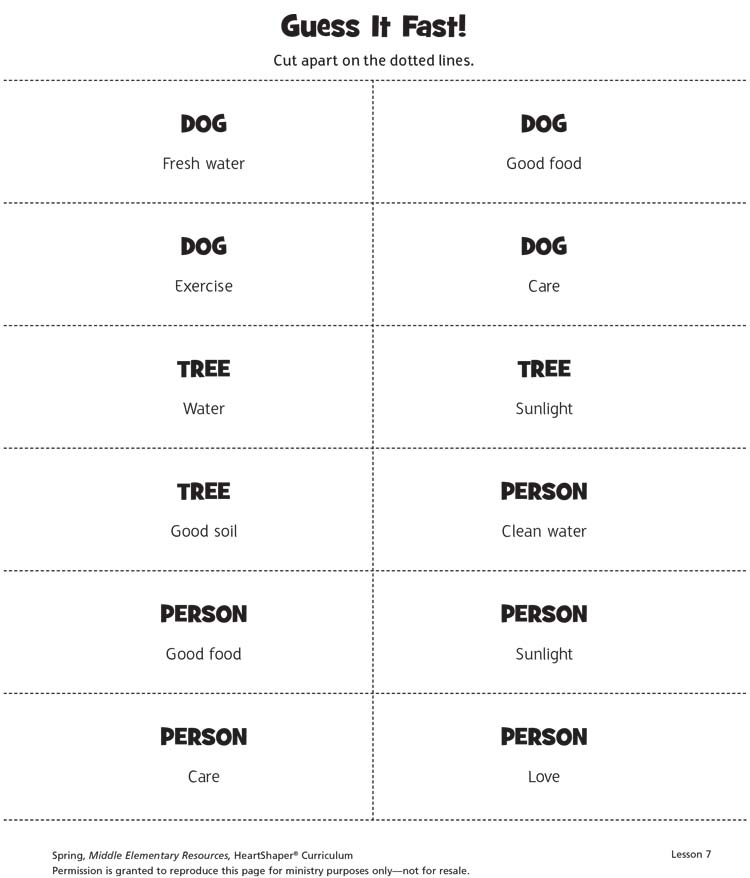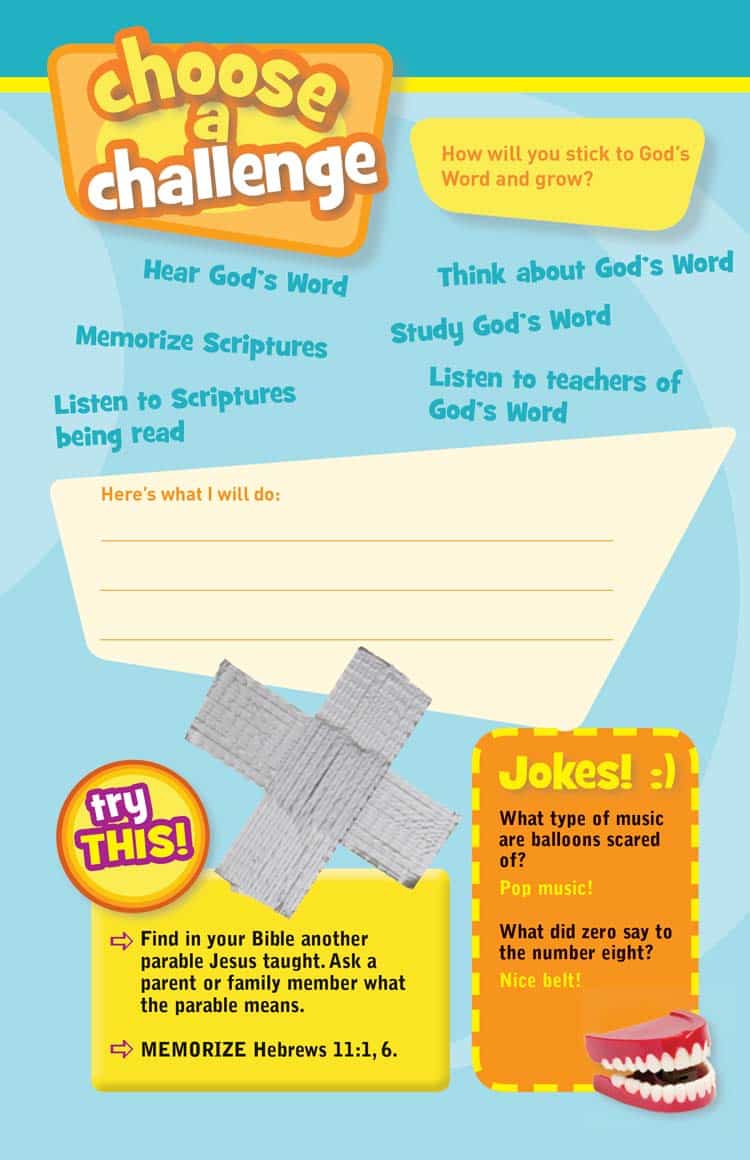Parable of the Sower Easy Read for Children
Use this lesson to teach elementary students the parable of the sower. It shows how Jesus wants us to grow!
Bible Basis: Luke 8:4-8, 11-15
Bible Memory: Hebrews 11:1, 6
Materials:
- How They Grow! Activity Page OR Guess It Fast! Activity Page; Scissors; Whiteboard; Dry-erase markers and eraser; Timer (counts seconds)
- Self-stick notes; Pencils
- Pretzel twists; Ribbon; Bibles
- Choose a Challenge Activity Page; Pencils OR Newspaper to cover tables; Foam cups; Markers; Good soil; Seeds (your choice); Plastic spoons

Parable of the Sower: Bible Background
Jesus told this parable as a large crowd was gathering (Luke 8:4). Jesus knew, however, that popularity could be fickle.
The parable He was about to give would illustrate that very point! Jesus' disciples needed to understand that not everyone would be open to the gospel message.
The seed represents God's Word. The seed lands on four different types of soil: hard, shallow, weedy, and good.
There is nothing wrong with the farmer or with his seed. Everything is dependent on the soil. Some seed "fell along the path" (v. 5). Hard-packed dirt walking paths divided fields.
This represents hard hearts that hear but refuse to believe.
"Some fell on rocky ground" (v. 6). Sheets of solid rock covered by thin layers of dirt caused seeds to sprout quickly, only to wither and die from the roots' inability to reach water.
Those represented by this kind of soil "believe for a while, but in the time of testing they fall away" (v. 13). Perhaps they believed all their problems would disappear when they accepted Christ.
"Other seed fell among thorns" (v. 7). Peer pressure, being with the wrong crowd, and not maturing spiritually can all become weeds that choke the life out of faith.
Those surrounded by thorns need to be transplanted to better surroundings whenever possible.
Despite the discouragement of many seeds falling on unproductive soil, some seed fell on good soil, producing a crop "a hundred times more than was sown" (v. 8). These are people who hear Jesus' message, take it to heart, and live by it.
The Parable of the Sower Opening Activities
Use one or more of these activities to help students explore how things and people can grow.
Activity 1: How They Grow!
Materials:
- How They Grow! Activity Page

ASK:
- How many inches taller are you now than you were a year ago? Let kids respond.
- How many inches taller are you now than when you were 2 years old?
- In what ways have you grown, other than getting taller? (gained weight, know lots more, care more about others)
Distribute the leaflets and pencils. Read the instructions aloud and do the How They Grow! activity together. (Answers: 1=c; 2=a; 3=d; 4=f; 5=b; 6=e)
SAY: It's fun to see how things and people look as babies, compared to
how they look as adults.
ASK:
- What do dogs need in order to grow? (fresh water, balanced diet, exercise)
- What do trees need in order to grow? (soil, water, sunlight)
- What do people need in order to grow? (clean water, balanced diet, sunlight, care, love)
SAY: Let's keep thinking about growing as we discover what the Bible says about it.
Activity 2: Guess It Fast!
Materials:
- Guess It Fast! Activity Page
- Scissors
- Whiteboard
- Dry-erase markers and eraser
- Timer (counts seconds)

Before class, make a copy of the Guess It Fast! reproducible page and cut apart the cards.
Divide the class into two teams. Tell kids they're going to play a game called Guess It Fast!
SAY: One at a time, you will come to the board and choose a card. You will say to your team only the word that's at the top of the card—dog, person, or tree. Then you'll draw on the board the item that's written on the card. Your team will try to guess what you're drawing. You have a total of 30 seconds to draw the item and for your team to guess what it is.
Tell students that the items on the cards are things that a dog, a person, or a tree need in order to grow. When the game is over, lead a discussion about growing.
ASK:
- How many inches taller are you now than you were a year ago? Let kids respond.
- How many inches taller are you now than when you were 2 years old?
- In what ways have you grown, other than getting taller? (gained weight, know lots more, care more about others)
Option: Some kids may not know how much they have grown in the age groups listed; this might be a hard concept for them. Provide pictures of babies and toddlers to help make this activity more concrete.
SAY: Let's keep thinking about growing as we discover what the Bible says about it.
The Parable of the Sower Bible Exploration
Use these activities to help students explain Jesus' parable of the sower.
Bible Passage: Luke 8:4-8, 11-15
Ask kids to turn in their Bibles to Luke 8:4. Have a volunteer read the verse aloud.
SAY: Jesus is ready to tell another parable.
ASK:
- What is a parable? (a story that has deeper meaning, a story that helps people think about things in a new or different way)
Read Luke 8: 4-8 aloud.
SAY: Back in Jesus' time, farmers would toss or scatter seeds to plant them. Of course, that meant that the seeds could go just about anywhere. In Jesus' parable, some seeds fell along a hard path. Those seeds were eaten by birds. Other seed fell on rocky ground. Those seeds grew into plants, but the plants soon withered because they didn't have enough water. Other seeds fell where there were thorns. Those seeds grew into plants, but the thorns choked them. The last group of seeds fell on good soil. You know what happened; the plants grew and grew! That happened because of the good soil. And that was the end of the parable. Remember, a parable is a story that has a deeper meaning.
ASK:
- Do you think the people understood the deeper meaning of Jesus' parable? (no)
- Do you think the disciples understood the deeper meaning? (no)
SAY: The disciples asked Jesus to tell them what His parable meant. Here's what He said.
Read Luke 8: 11-15 aloud.
SAY: Just because someone hears the Word of God, it doesn't mean he is going to stick with it, does it?
Divide the class into four groups. Assign each group one of the four kinds of soil. Each group is to plan how to act as people who are like their kind of soil. If you have a small class, let individuals or pairs of kids represent the soils.
When groups are ready, let them do their acting.
SAY: I hope that you choose to be like the good soil, hearing and taking Jesus' message to heart and living by it. Jesus doesn't want us to just come to church services or just listen to God's Word. Jesus wants us to stick to God's Word and grow. Let's discover how we can do that.
Bible Memory: Hebrews 11:1, 6
Materials:
- Self-stick notes
- Pencils
"1 Now faith is confidence in what we hope for and assurance about what we do not see."
"6 And without faith it is impossible to please God, because anyone who comes to him must believe that he exists and that he rewards those who earnestly seek him."
Hebrews 11: 1,6
Have kids turn in their Bibles to Hebrews 11:1, 6, and have volunteers read the verses aloud.
ASK:
- How do we learn about faith in Jesus? (from the Bible, from other Christians)
SAY: The Bible tells about people who had a lot of faith, such as Joseph and Mary, Jesus' parents, and Jesus' disciples who left everything to follow Him. Jesus wants us to stick to God's Word and grow too. And a big way that Jesus wants us to grow is in our faith. He wants us to have an amazing faith, a faith that shares God's Word with others.
Give each student a self-stick note.
SAY: Write on your notes someone you know who sticks to God's Word and is growing in his or her faith. This might be a parent, other relative, friend, teacher, or someone else you know.
Ask kids to put their notes on a wall or bulletin board (they don't need to include their own names). When kids have done this, read what they've written.
SAY: When you know people who stick to God's Word and are growing, those are great people to listen to and learn from to help your faith grow.
Have all the kids read or say the Bible Memory verses together.
The Parable of the Sower Application Activities
Use these activities to help students discover why and how to stick to God's Word and grow.
What Good Is It?
Materials:
- Pretzel twists
- Ribbon
- Bibles
Tie a piece of ribbon around a pretzel. Ask a volunteer to sit by you in a chair. Tell the volunteer that they can have the pretzel if they can get it. But they are not allowed to get up from the chair or use their hands. Dangle the pretzel in front of them, but at a distance that they cannot reach.
ASK:
- What good is food if you can't eat it? (none)
- What good is God's Word if all you ever do is hear it? (none)
Give kids some pretzels to snack on. Have a volunteer read Matthew 4:4 aloud. Then have another volunteer read 2 Timothy 3:16, 17 aloud.
ASK:
- Why should we stick to God's Word? (We need it in order to live. It's useful for teaching, training us to live for God, and helping us do good things.)
Have a volunteer read Psalm 119:11 aloud. Then have another volunteer read 1 Timothy 4:13.
ASK:
- How can we stick to God's Word and grow? (memorize Scriptures, listen to Scriptures, listen to teachers of God's Word, study it, think about it)
SAY: Jesus wants us to stick to God's Word and grow. I challenge you to be like the good soil in Jesus' parable. Always be ready to hear, read, study, think about, and memorize Scripture.
Teaching Tip:
Be sure to tell the kids that this is a game to help them understand the lesson. This may allay frustration and help them to connect to the meaning.
Remember to check for food allergies. Try to purchase gluten free pretzels.
The Parable of the Sower Closing Activities
Use one of these activities to help students choose to stick to God's Word and grow.
Activity 1: Choose a Challenge
Materials:
- Choose a Challenge Activity Page
- Pencils

SAY: The parable Jesus told was a good story, but it wasn't just a good story. Jesus' parables always had deeper meanings. From this parable about the sower, we learn that Jesus wants us to stick to God's Word and grow. Will you choose to do that?
Pass out the Choose a Challenge activity page and pencils to each kid.
SAY: Decide how you will put Jesus' teachings into practice, how you will stick to God's Word and grow. Choose at least one of these things to put into practice. Write on the lines what you will do.
If any volunteers want to tell what they're choosing to do, let them share that with everyone.
Have kids gather for prayer. Ask kids if they've ever kneeled when they have prayed. Kneel, and ask the kids to also kneel.
SAY: Being close to the ground reminds me of today's parable. Let's pray and ask God to help us always be good soil, sticking to God's Word and growing.
After a short time of silence, close in prayer.
Activity 2: Good Soil Cups
Materials:
- Newspaper to cover tables
- Foam cups
- Markers
- Good soil
- Seeds (your choice)
- Plastic spoons
Provide assistance to kids who may struggle with fine-motor activities, or prep some of the materials ahead of time.
SAY: The parable Jesus told was a good story, but it wasn't just a good story. Jesus' parables always had deeper meanings. From this parable we learn that Jesus wants us to stick to God's Word and grow. Will you choose to do that?
Cover tables with newspapers. Give each student a foam cup.
SAY: On your cups, write at least one way that you will choose to stick to God's Word and grow. You might also want to draw some pictures or write out some Scriptures.
When kids are done with their cups, let them put some good soil in their cups and then plant a few seeds.
SAY: Your cups are full of good soil, so those seeds will grow if you give them enough water and sunlight. I challenge you to be like the good soil in Jesus' parable. Always be ready to hear, read, study, think about, and memorize Scripture.
Close with a time of prayer. Encourage volunteers to pray aloud, asking for God's help to stick to His Word and grow.

Did you enjoy this lesson? It was adapted from HeartShaper Children's Curriculum, Middle Elementary. To learn more about this age level, check out the video below or visit HeartShaper.com.
Need more parable lessons? We've got you covered!
- Parable of the Prodigal Son
- Parable of the Sheep and the Goats
- Parable of the Talents
- Parable of the Good Samaritan
Source: https://ministryspark.com/parable-of-the-sower-elementary/
0 Response to "Parable of the Sower Easy Read for Children"
Post a Comment